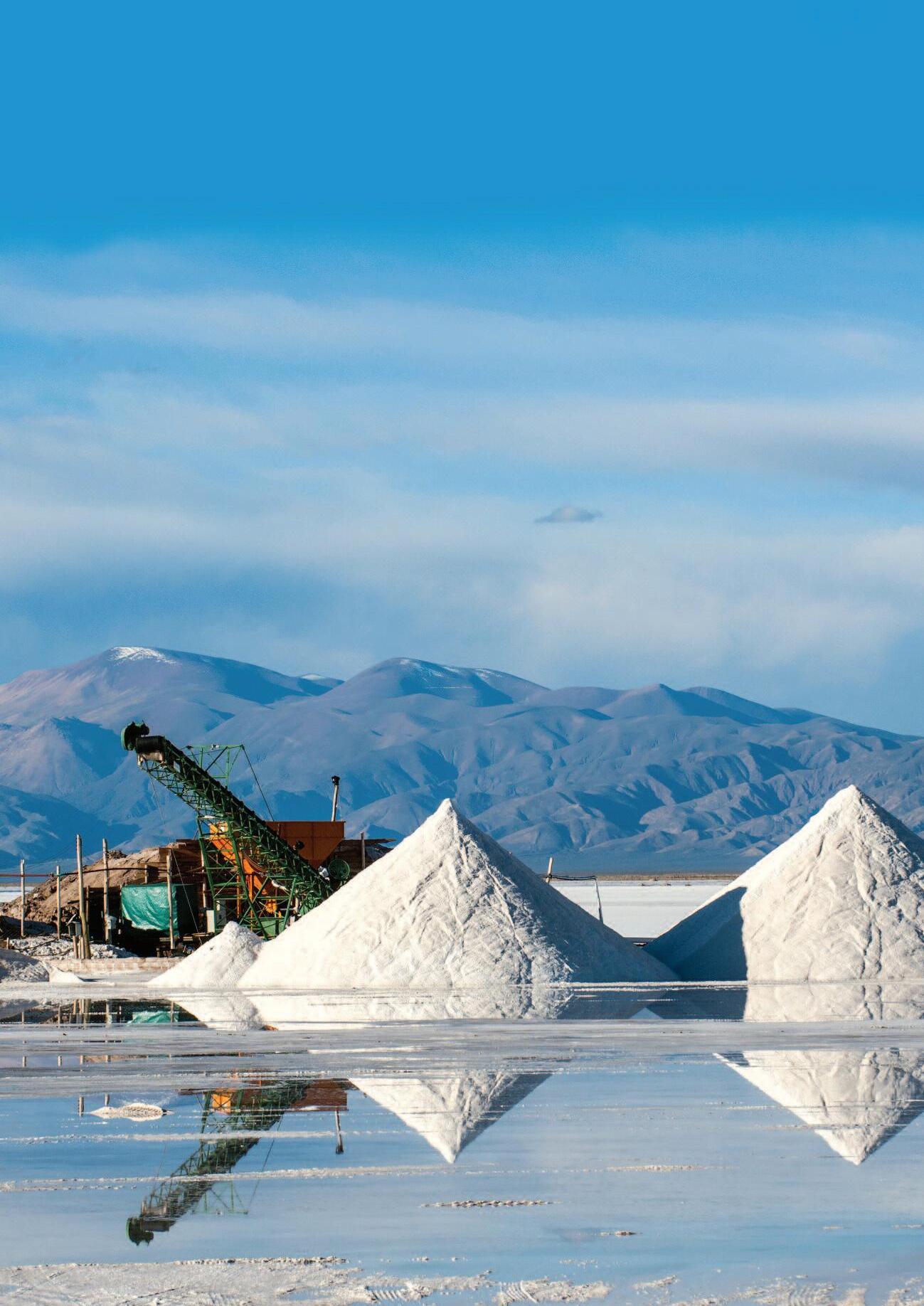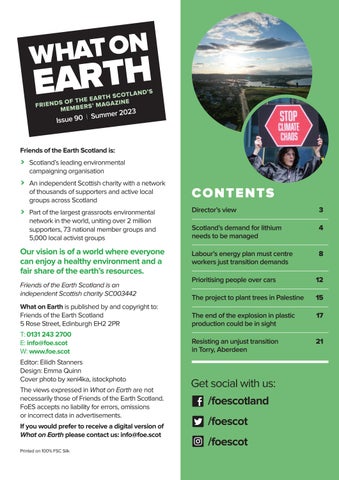Managing lithium demand is vital for a just transition

WHAT ON EARTH
FRIENDS OF THE EARTH SCOTLAND’S MEMBERS’ MAGAZINE
Issue 90 I Summer 2023
Friends of the Earth Scotland is:
> Scotland’s leading environmental campaigning organisation

> An independent Scottish charity with a network of thousands of supporters and active local groups across Scotland
> Part of the largest grassroots environmental network in the world, uniting over 2 million supporters, 73 national member groups and 5,000 local activist groups
Our vision is of a world where everyone can enjoy a healthy environment and a fair share of the earth’s resources.
Friends of the Earth Scotland is an independent Scottish charity SC003442
What on Earth is published by and copyright to:
Friends of the Earth Scotland
5 Rose Street, Edinburgh EH2 2PR
T: 0131 243 2700
E: info@foe.scot
W: www.foe.scot
Editor: Eilidh Stanners
Design: Emma Quinn
Cover photo by xeni4ka, istockphoto
The views expressed in What on Earth are not necessarily those of Friends of the Earth Scotland FoES accepts no liability for errors, omissions or incorrect data in advertisements.
If you would prefer to receive a digital version of What on Earth please contact us: info@foe.scot

Director’s view
Gracie Bradley, Director
We’re halfway through the year already and it’s busy as ever at Friends of the Earth Scotland. We are now several months into developing our exciting new organisational strategy, which will run from 2024 – 2026. This was at the top of my list when I joined the team at the end of January this year.

We have run an open and participatory consultation process. We’ve come together to think about the basic question of what strategy is, to map our movement, and to look at what we achieved in our last strategy, and what work there still is to do. We’ve also deliberated on the political, economic and scientific contexts, whether our existing vision and mission are fit for purpose, and what our values should be.
We also sent a link to a survey to all of you, our members, in the last issue of What on Earth, which yielded some very interesting insights, as did the strategy discussion at our AGM. We held a great session for people involved in our local groups and we sent out questionnaires and held consultation meetings with other allies and critical friends.
Once I’ve synthesised all of these inputs into a draft, it will be up to our board, as representatives of our membership, to amend and sign it off in September, and then we’ll get to work on making plans for the following year.
While facing down climate and environmental harm is an increasingly daunting task, we’re confident that a well-resourced, thoughtful and agile strategy will put us on a strong footing for the hard work ahead.
Thanks as ever for your support and I hope you enjoy this edition of the magazine.
Scotland’s demand for lithium needs to be managed
By Kim Pratt, Circular Economy CampaignerLithium is having a moment in the news. The soft, silvery metal has been extracted commercially for over a century with a wide range of uses, but its demand is rising.


The most common use of lithium today is rechargeable batteries, and the main use of those is electric vehicles. This means that as we move from fossil fuel cars, our demand for lithium is going to increase rapidly (by between 13 and 51 times from 2020 to 2040, depending on how rapidly decarbonisation takes place), and there are already fears of running out in as soon as a few years’ time.
In 2022, Scotland consumed an estimated 142 tonnes of lithium. The bulk of this consumption – 82% – went towards private cars.
As well as the valid concerns around shortages, there are numerous other concerns about lithium mining and production. There is evidence of social and environmental impacts, including human rights abuses, connected with the lithium supplied to the Scottish economy Mining is associated with conflict because exploitation of mineral resources impacts upon nearby communities. It is an extremely energy intensive process and generates large amounts of toxic waste. It’s even more carbon intensive than coal mining There are also labour rights concerns reported right across the lithium supply chain, which is global and complex
The current global recycling rate for lithium is just 1%.
Lithium-ion batteries used in Scotland are most likely to contain lithium from Chile and Australia. In both countries there is evidence of corruption, worker exploitation and mines depleting water sources for Indigenous communities and wildlife.
In Chile, brine evaporation, which uses vast quantities of water in an already parched environment, is one of the most significant concerns Mining activities are said to have consumed 65% of the Salar de Atacama region’s water The mining practices in the region mean that freshwater is less accessible to the 18 Indigenous Atacameno communities that live on the Atacama’s perimeter.
Unionised workers have also protested against exploitative working conditions
In 2021, workers settled a dispute at Albermale’s Salar de Atacama facility after opposing a contract which restricted union freedom and discriminated against the plant’s most vulnerable workers.
On the Maricunga Salt Flat, also in Chile, various companies are developing projects on the lands of the Colla People. Mining activities have disrupted their ancestral ceremonies, violating their Indigenous rights. The project developers, Minera Salar Blanco, assert they undertook a ‘lengthy process of social engagement’, but the communities say that they did not gain the consent of those affected The nearby Sales de Maricunga project, run by a consortium of three Chilean, Taiwanese and Japanese companies, offered no consultation at all.
Large-scale depletion of salt water from the aquifers also endangers various native species, including unique wetlands where fauna and flora – including migratory birds, the Andean fox, numerous small mammals – coexist in fragile circumstances
The impacts of mining lithium have led to public debate recently around whether we should be moving to electric vehicles at all The short answer is yes, we should. We must stop burning fossil fuels to meet our climate goals, which means fossil fuelled cars must be taken off our roads as soon as possible
Satellite image of lithium brine extraction sites in Salar de Atacama region of Chile in 2018, showing evaporation ponds using brine pumped from below the surface

The long answer requires a rethink of our transport system.
Replacing all our current petrol and diesel cars with electric cars like for like would reduce carbon emissions on our roads in Scotland but would not reduce overall demand for cars and the associated production emissions globally. We need better public transport and investment in infrastructure for cycling, wheeling and walking, so we don’t need as many cars overall.
Replacing Scotland’s 2.5 million fossil fuel cars and 4,400 buses like for like would require 20,200 tonnes of lithium in total. If the proportion of journeys in Scotland taken by bus increased to 30% (which would bring the proportion of journeys made by public transport in Scotland up to the levels we see in London today) lithium requirements would be 13,800 tonnes (32% less).
We also need to stop using lithium for unnecessary purposes Single-use vapes, which have a readily available reusable alternative, each have a lithium-ion battery With an estimated 1.16 million bought each month and 108,000 thrown away each week across Scotland, this is enough lithium to produce around 99 electric car batteries in a year
As well as reducing demand, better use of lithium once it enters the economy can also limit its impacts by replacing requirements for new resources We need better reuse and recycling of lithium batteries. The batteries used in electric vehicles still retain around 80% of their capacity when they reach the end of their life, so with the right processing they can still be used for less demanding applications for many more years. At the moment, it’s not clear who owns batteries when they reach the end of life in electric vehicles The Scottish Government must provide clarity on this to ensure responsible companies can act to increase reuse and recycling of batteries.
In Scotland, our consumption of goods and services has global impacts. We want the Scottish Government to create a resource justice strategy to ensure it’s taking into account all of these issues, and the similar ones that arise from the other minerals that will be in high demand as we transition away from fossil fuels. This must both drive supply chain due diligence, and minimise mineral demand. Transitioning away from fossil fuels is vital for a liveable planet, but we must not create another crisis in doing so.

Transitioning away from fossil fuels is vital for a liveable planet, but we must not create another crisis in doing so.
Labour’s energy plan must centre workers’ just transition demands
By Freya Aitchison, Oil and Gas CampaignerThe Labour Party has recently announced that it would oppose all new oil and gas licensing should they win the next election, which has caused quite a stir in the media. Starmer actually announced Labour’s plans to end future licensing rounds back in January, at a speech at the World Economic Forum in Davos, but the recent stories have seen a confirmation of existing commitments, and a pledge to include them as part of Labour’s ‘national missions’.

Energy experts and climate scientists in the International Energy Agency, Intergovernmental Panel on Climate Change and many more respected institutions have been saying with increasing urgency that in order to limit climate heating to 1.5C there cannot be any new investment in fossil fuel developments. With the impacts of the climate crisis becoming devastatingly clear both in the UK and across the globe, now is the time to be taking decisive action.
Since Labour’s announcement, there have been questions about the controversial Rosebank oil field, which Ed Miliband, Shadow Secretary of State for Climate Change and Net Zero, had previously said should not go ahead because it “won’t cut bills by a penny”.
The need to phase out oil and gas is crystal clear.Photo: Wikimedia Commons/Rwendlands
As Rosebank already has a licence, but is yet undeveloped, this announcement won’t affect whether it goes ahead or not.
However, Labour has confirmed that if Rosebank, or any other project were given permission to start production by the current UK Government, they would honour that decision and allow drilling to continue if they win the next election. This is highly problematic because research has shown that if we are to limit warming to globally agreed 1.5C, 40% of fossil fuels in already licensed fields need to stay in the ground, in addition to all undeveloped reserves.

Because of the greater responsibility that the UK and other rich countries bear for causing the climate crisis, there is a duty under international law for us to do the most to tackle this crisis
This means we need to phase out our fossil fuel extraction and use first. If all the oil and gas in Rosebank alone is burned, it will produce the equivalent of the combined annual carbon dioxide emissions of the world’s 28 lowest income countries.
Whoever is running the country must accept the reality that no new projects can be allowed to go ahead and set a clear end date for oil and gas extraction, to give clarity and focus on the transition to a renewable energy future.
A couple of weeks after the announcement on oil and gas licensing, Labour’s Shadow Chancellor Rachel Reeves announced that the party would water down their previous commitment to borrow £28 billion per year until 2030 for climate-friendly investments Instead they will build up to £28 billion per year by the middle of their term, in what is a major backslide on a flagship pledge from Labour
there is a duty under international law for us to do the most to tackle this crisis
While the original pledge of £28bn per year is a good start, and should be used to nationalise or take stakes in strategic energy infrastructure, such as the grid and ports, and to invest in regional publicly owned renewable generation companies, much more is needed
In a speech in Edinburgh on 19th June, Starmer revealed that Labour’s plan for a publicly owned energy generating company would be headquartered in Scotland With the profit driven energy firms having demonstrably failed to deliver on climate action, or keep energy affordable for householders, public ownership clearly must be at the heart of any robust just transition strategy Public ownership means that objectives like keeping peoples’ homes warm and bills affordable, and reducing environmental harm, can be prioritised over profit If it is set up in the right way, Labour’s Great British Energy Company coming to Scotland could help bring decent green jobs in manufacturing, construction and retrofitting. Reforming contracts with energy generators and putting conditions in place, which Starmer additionally committed to, will also help create decent green jobs here in Scotland, and across the UK.

Finance for the ramping up of renewable energy, as well as energy efficiency schemes to reduce demand for oil and gas are essential for ensuring a just transition and a liveable future.
The Labour Party needs to provide a lot more detail about how they will ensure a just transition away from oil and gas and put the interests of workers and communities at the heart of their policies. Earlier this year, we worked with a coalition of offshore oil and gas workers, climate groups and trade unions to create a new plan that would deliver a just transition away from fossil fuels to protect jobs, communities and climate. Over 1,000 surveyed oil and gas workers support transformative demands, including:
> Clear accessible pathways out of high carbon jobs, and a training regime for safety, not profit
> Investment in domestic manufacturing and assembly of renewables
> Ensuring safety, job security and fair pay across the energy industry
> Sharing the benefits of our energy system fairly, through public ownership, reorganising the tax system for public good and targeted public investment
The Labour Party should take their lead from these demands when developing their energy policies Oil and gas workers are ready to lead a rapid and fair transition away from fossil fuels, and have a blueprint to create an energy industry that protects workers, communities and the climate.

All that is required is the political will to get behind their demands.
Prioritising people over cars
By Eilidh Stanners, Communications OfficerIn August, The Highland Council will make a decision that could shape the future of the city centre of Inverness, making it a better place to live and spend time. The proposal is to increase the pavement size along Academy Street and introduce a bus lane – this will cut traffic, reduce air pollution, and make this area of Inverness a greener and more welcoming place.

Transport is Scotland’s biggest source of climate emissions, and cars are by far the biggest chunk of that. When we take a little space away from cars in the most built-up areas, we reclaim space for all kinds of purposes: walking, wheeling, cycling, street trees, rain gardens, outdoor seating, food stalls, parks and more all become possible when we stop prioritising cars
Reducing traffic in the centre of Inverness will be very welcome in improving one of the country’s most polluted streets, following changes to Glasgow’s George Square, which has been pedestrianised, with the green space planned to be extended. These small changes are positive steps, but if we look further afield, we see that Scotland’s cities are currently quite far behind
If we look to some of the ways cities in Europe are reducing car traffic, it’s clear that we can be much more ambitious.
Paris has made a remarkable shift away from cars recently by pedestrianising parts of the city, investing in public transport and making cycling safer. Car trips within the city dropped by almost 60% between 2001 and 2018. Now, the city plans to ban cars from crossing the first four arondissemonts, a big chunk of the city centre, by early next year. The so-called “tranquil zone” is part of the plan to improve conditions in the city ahead of the Olympic Games
In Barcelona, one of the densest cities in Europe, the mayor has created a system of ‘superblocks’ This means that by grouping blocks in the city centre together, they’ve been able to free up space to use as public squares and green areas. The mayor’s plan has focussed on deprioritising cars, and has already made an impact of the city’s air pollution problem. The superblocks will form a network of green hubs, and the aim is for all Barcelona residents to be within 200 meters of one
Oslo is a fantastic example of the benefits outside of climate and air pollution that reducing car traffic can bring – it has brought pedestrian and cyclist deaths down to zero, and footfall in the city centre has increased tenfold. One of the criticisms that is sometimes thrown at pedestrianisation is that it would negatively affect local businesses, but the inverse is actually true.

When city centres are being used as through-routes, local businesses suffer – safer streets means more people spending time in the area and visiting local shops and services.Photo: Migual Discart / Climate Visuals
It’s exciting to see the rate of change happening in cities across Europe, and it is inspiring to see how quickly our urban landscapes can change, but we know it’s not always easy and it certainly doesn’t happen without people pushing for it. In Paris, campaigners made an annual car-free day happen, which grew in size every year and paved the way for more and more changes to be made – and they’re not stopping with where they’re at now.
In Inverness, we’ve seen some fantastic campaigning that’s lead to the proposed changes that are happening now. Campaign groups like Kidical Mass have galvanised the city and helped make visible the roblems and possibilities, and in turn this has made the council listen.
If the council votes through the changes, it could be the start of some great changes in Inverness. The city will become a better place to spend time, and its residents will finally begin to breathe easier.

We’re so used to cars being prioritised in our cities that it can be hard to imagine the alternative, but by prioritising people instead we could tackle the climate emissions from transport and improve our cities for the people who live and spend time in them.
In Inverness, we’ve seen some fantastic campaigning that’s lead to the proposed changes that are happening now.
The project to plant trees in Palestine
 By Manal Shqair with introduction from Eurig Scandrett, Friends of the Earth Scotland member
By Manal Shqair with introduction from Eurig Scandrett, Friends of the Earth Scotland member

At Friends of the Earth Scotland’s AGM, members voted unanimously to support the Plant a Tree in Palestine project of the Stop the JNF campaign. Stop the JNF is an international campaign against the Jewish National Fund, an organisation that claims to be environmental but uses greenwash to cover for its central purpose: the ethnic cleansing of Palestinians.
Friends of the Earth Scotland has supported Stop the JNF for ten years and is a signatory to the petition to keep the JNF out of COP26. Exposing greenwash and international solidarity has always been part of our work, and through our links with Palestinian activists and Scottish solidarity groups,
we have been keen to expose the JNF. Here, Manal Shqair, a Palestinian activist with Stop the Wall campaign (a member of Friends of the Earth Palestine), writes about the JNF and the value of the Plant a Tree campaign.
The Plant a Tree Campaign was launched in 2011 as a joint effort between Palestinian grassroots activist groups and international solidarity organisations.
The project is part of Stop the JNF Campaign, an international campaign that aims to hold the Jewish National Fund accountable for its complicity in the ethnic cleansing of Palestinians and in greenwashing Israeli apartheid settler colonialism.
The JNF was established in Britain in 1901 for the purposes of obtaining land in Palestine as a custodian for ‘the Jewish people’, expelling the Palestinian population. It is now formally connected to the state of Israel where it exerts significant influence over Israel Lands Authority, operates in the occupied Palestinian territory, and has branches in over 50 countries, including Scotland (KKL Scotland) and the UK (JNF UK).
The JNF is one of the key organisations enabling the operation of Israeli ethnic cleansing, apartheid and the illegal settlement enterprise through acting as a fundraiser for Israeli crimes against humanity It raises funds internationally to ‘plant a tree’ for its afforestation projects on the ruins of destroyed Palestinian villages and other (unsustainable) environmental activities, and so wears an environmental garb to greenwash Israeli apartheid
The Plant a Tree in Palestine campaign aims to challenge the JNF’s colonialist and apartheid activities through active involvement in the struggle of Palestinians to protect their land on the ground.
In the last couple of years, we have planted thousands of trees in areas threatened by illegal Israeli settlement expansion in the West Bank.
It is not possible to replace what is lost when people are displaced, land and a way of life is destroyed, 1,000-year-old olive trees uprooted. In Palestine scores of 2,000-year-old cities and historical sites are buried under JNF planted forests and parks. Rebuilding and replanting are acts of daily resistance in Palestine.
This project seeks to support the ongoing struggle of Palestinians to sustain and rebuild their land by providing resources for villages to plant trees that are indigenous to Palestine’s natural environment and agricultural life.
The campaign acts as a sustainable and anti-colonial tool to reinforce the sumud (steadfastness) of Palestinian farmers
Through emphasizing the intertwinement between sustainable environmentalism and the Palestinian struggle for self-determination, the Plant a Tree campaign also challenges Israeli greenwashing narrative positing Israel as an environmental steward to legitimise and naturalise its apartheid settler colonial structure

Rebuilding and replanting are acts of daily resistance in Palestine.
The end of the explosion in plastic production could be in sight
 By Kim Pratt, Circular Economy Campaigner
By Kim Pratt, Circular Economy Campaigner
Plastics are everywhere: we wrap our food in it, our clothes are woven out of it and billions of products are made of it. These products are often designed to exploit plastic’s most well-known properties –it’s cheap and versatile.
Every year, 300 million tonnes of plastic is created but if you think there is a lot of plastic in your life right now, imagine what living in 2060 will be like, when plastic production is forecast to triple. But this doesn’t have to be the case, and we’re hopeful that a new international agreement could stem the tide.
The problem with plastic
Despite the fact that plastic can be found in every part of our lives, there is mounting evidence that it is extremely harmful. It’s now well known that plastic pollution is a problem for the environment.
Although many plastic products are thrown away after a single use, the material itself survives for hundreds of years Plastic litter covers our towns and countryside and clogs up our oceans Even when plastic breaks down, the resulting microplastics can go on polluting for years to come
There are also less visible ways in which plastic damages our lives Plastics are intertwined with the climate crisis because 99% of plastics are made from fossil fuels –this means that producing plastic is damaging the planet, not just throwing it away.
There’s also growing evidence about the impact of plastics on our health. 7,000 potentially harmful chemicals have been found in plastics in products such as packaging (including food contact materials), toys, textiles, furniture, building materials, medical devices, personal care and household cleaning products.

Exposure to these chemicals can cause neurological and hormonal conditions and cancers.
The global plastics production system deepens existing injustices that disproportionately harm Indigenous, black, brown and low-income communities Most plastics are used in rich countries but then the rubbish is sent to countries in the Global South to be dealt with by unofficial waste pickers who are vulnerable to exploitation. There is evidence of child labour, poisonous chemical exposure, and worker exploitation.
producing plastic is damaging the planet, not just throwing it away.
The Global Plastics Treaty

The world is slowly waking up to the fact that we are living in a plastics crisis
In November 2022, countries around the world began negotiating on a legally binding Global Plastics Treaty to end plastic pollution A series of international meetings are happening in the lead up to the final agreement expected by the end of 2024. It has the potential to be a landmark success in environmental diplomacy.
The draft treaty tackles the whole lifecycle of plastics from design and production to use and disposal, which is needed to address the scale and complexity of the issue. It recognises that the chemical impact of plastics must be addressed Most of the UN Member States are supporting the treaty and the process has brought together indigenous people, workers, trade unions, waste pickers, environmental groups and scientists.
Unfortunately, there are still concerns that need to be overcome. The negotiations have involved the plastics industry, including oil and gas lobbyists, and the promising start to the treaty is beginning to be overshadowed by industry involvement. At the last round of negotiations, in June of this year, industry was accused of deliberately slowing down the process to limit what could be agreed.
Community groups and environmental organisations are calling for the Global Plastics Treaty to include requirements for environmental justice, a just transition for waste pickers and others and to find solutions to the plastic crisis which does no harm to the climate, biodiversity or human health. This is currently being overlooked but it is essential to create a fairer future
The Montreal protocol – the first treaty to be ratified by every country on Earth – has phased out the use of nearly 100 substances that attack the planet’s protective ozone. If it’s successful, the impact of the Global Plastics Treaty could be as significant.
Scotland’s Role
The UK is part of a coalition of over 50 governments which are calling for an ambitious Global Plastics Treaty. However, this commitment needs to be backed by action which can start right now Scotland needs to play its part in this. The petrochemical giant, INEOS, based in Grangemouth, is Europe’s top producer of ethelyne, which is used in making more than half of plastic and petrochemical products, including single use plastics. We urgently need a plan to phase out plastic production and convert the Grangemouth site to the green industries of the future, supporting workers and the local community in the process as part of a just transition

A new law which aims to create a circular economy to make material use more sustainable has just been introduced to the Scottish Parliament. This is an important opportunity to create a strong framework to reduce the amount of plastic and other materials Scotland uses and to take responsibility for impact of Scotland’s plastic consumption overseas. We need to regulate producers to design products from lower carbon materials, that are built to last and be easily repairable.
In Scotland, we should be aiming for a future which is free from the harm that plastic does to the environment, to our bodies and to people across the world. We can strengthen global efforts to do this by creating the change we want to see here in Scotland
We need the new circular economy law to be as strong as possible. If you want to get involved in making this happen, we have created an activism pack which you can access on our website: www.foe.scot/circular-economy-action
Resisting an unjust transition in Torry, Aberdeen
 By Scott Herrett, Just Transition Organiser
By Scott Herrett, Just Transition Organiser
The Friends of St. Fittick’s Park’s campaign aims to protect the greenspaces in and around Torry from unjust corporate land grabs, with a particular focus on the last accessible greenspace in Torry, St. Fittick’s Park. I’ve been working to directly support the Aberdeen based campaign ever since I started my job with Friends of the Earth Scotland as a Just Transition Organiser in 2021, and they are still resisting today
St Fitticks Park is a beautiful wild park in Torry full of diverse nature. It is the only green space in walking distance for many people and has been described by locals as a “sanctuary” and by ecologists as “irreplaceable” Yet, the local residents who enjoy it are having to fight to protect it
The park is under threat from a private land grab under the guise of an Energy Transition Zone, backed by Aberdeen City Council, and oil tycoon Ian Wood While there’s no doubt we need to transition away from fossil fuels urgently, we must do so in a way that’s fair to communities. The injustice the people of Torry are facing is a clear example of what needs to be avoided
When I first arrived in Aberdeen in 2016, I was shocked to find a city where hardly anyone was taking the climate crisis seriously, in particular the role the city has in its relationship to the oil industry The industry employs a lot of people here and combined with that fact that the downturn a few years earlier had led to many people losing their jobs and their homes, it was a difficult subject to approach.
My arrival coincided with the plans for Aberdeen’s new south harbour being approved The visitor centre and associated publicity was all about accommodating cruise ships and decommissioning efforts in the North Sea, but there was no mention of energy transition or how it could happen fairly. I later learnt that this new harbour is really all about moving oil supply boats that moor in the city centre, to free up space for profitable waterside developments
Fast forward to 2019: the IPCC report came out and the climate movement grew beyond anything we’d seen before, with Extinction Rebellion coordinating mass civil disobedience and school kids across the country taking part in school strikes. The media shifted in the way it covered climate issues, and environmental issues became more mainstream. All of a sudden, the social license to produce oil and gas was being eroded.
Back to St. Fittick’s Park, it was in this context that Ian Wood announced his new company Energy Transition Zone Ltd (ETZ Ltd). The ‘energy transition zone’ is described as a plan to build sites for turbine manufacturing, research, development, testing and deployment; with significant opportunities in offshore wind, hydrogen, carbon capture and storage, in the hope that this will encourage ‘green’ companies to come to the area ETZ Ltd carried out a feasibility study to find land for the so-called ‘energy transition zone’ It identified land left abandoned by the oil
industry and land around the new harbour that includes the thriving greenspace and wetland of St. Fittick’s Park. When planning permission for the new harbour was granted, it was on the condition that the greenspaces around the harbour would be left and enhanced
The story of how much has been dumped on the people of Torry over the past 50 years is a sorry one, but it needs repeating time and again while the community is facing further injustice. Homes were demolished in the 60s to make way for a harbour extension, the community was burdened with a toxic open landfill bordering the south, later a sewage treatment works was built next to the park. Torry has noise and air pollution from two industrial estates, as well as one of Scotland’s most polluting roads to the west. In recent years the Bay of Nigg has been destroyed to make way for new harbour, and a massive new waste incinerator is about to start up only 400 yards from the local primary school.

It’s one of Scotland’s poorest communities, and having endured this history of environmental violence, it’s unbelievable that anyone could argue it should be forced to give up this thriving greenspace.
The proposed Local Development Plan –that included changes to pave the way for St. Fittick’s Park and surrounding greenspace to be industrialised – has now been adopted by the city council after being given the greenlight from the Scottish planning minster, Joe
FitzpatrickIn the weeks and months to come, it’s likely that the main developer will submit a formal planning application to Aberdeen City Council – so even with the Scottish Government giving the green light to the local development plan there are still many opportunities to oppose this unjust plan through the local planning process, as well as potential legal routes
The transition away from an economy based on fossil fuels is an opportunity to create a better society and protect the poorest from climate impacts. If the transition is led by people and communities, they can ensure it is truly fair and meets their needs. What we’re seeing in Torry is the opposite of that
The ‘transition’ plans being imposed on the Torry community are far from just, or even green. They show a blatant disregard and lack of engagement with the communities that should be at the heart of the transition.

We’ll continue to support the community in this fight, and if you want to get involved with the campaign to join local people and help to build a movement that the Scottish Government and Aberdeen City Council can no longer ignore, visit www.saintfittickstorry.com



